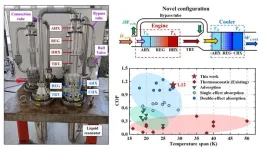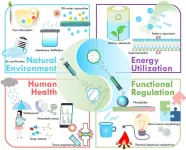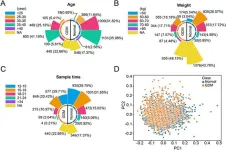(Press-News.org) While surgery to remove rectal cancer can be necessary and lifesaving, it can sometimes come with significant drawbacks, like loss of bowel control. According to a study led by Wilmot Cancer Institute researchers, patients with rectal cancer who respond well to radiation and chemotherapy are increasingly foregoing surgery and opting for a watch-and-wait approach.
The study, published in JAMA Oncology, shows that the number of patients opting out of surgery rose nearly 10 percent between 2006 and 2020. These data reflect a shift toward what is known as an “organ-preserving” approach to care: It requires patients to undergo frequent follow-ups with experienced oncologists over five years, but potentially allows them to avoid surgery that could alter their bowel function and quality of life long term.
“You don't appreciate your bowel function until it's bad,” says Fergal Fleming, MD, MPH, a Wilmot investigator and associate professor of Surgery and Oncology at the University of Rochester Medical Center who led the study. “For many of my patients, their bowel habit, unfortunately, dictates their lives. So, if we can avoid surgery, then that's probably much better for patients in terms of quality of life.”
Wilmot’s Colorectal Cancer Program is a national leader in watch-and-wait organ preservation, having practiced this relatively new approach to care for nearly 10 years.
“It’s somewhat similar to the evolution of breast cancer care,” Fleming says. “Patients used to have very extensive mastectomies and resections, whereas now breast conservation is offered wherever feasible.”
Not yet part of standard clinical care, this organ-preserving approach is primarily available to patients through clinical trials. Wilmot is involved in several such trials, including the national Organ Preservation in Patients with Rectal Adenocarcinoma trial, which recently reported that half of the patients who opted to watch-and-wait were able to avoid surgery long-term. The other half, who had surgery after their cancer regrew, had the same disease-free survival rates as patients who did not watch-and-wait.
These positive early results and Fleming’s study suggest that a sea change in rectal cancer care is imminent. But Fleming cautions that better guidance is needed before watch-and-wait care can be used more broadly.
Current treatment strategies vary widely—and the intensity and length of the follow-up program can be difficult for patients to adhere to. More work is needed to define the optimal surveillance approach—one that is rigorous enough to spot cancer regrowth early, but easy enough for health systems to implement and patients to follow.
“Having patients in an integrated system like we have at Wilmot is so important,” Fleming says. “We’re all on the same page, giving our patients consistent messages. We try to facilitate as much of their follow up as possible, and coordinate with affiliate units to try and make it easier for patients to make it to appointments.”
But not all cancer centers are set up that way and not all rectal cancer programs have the resources and experience to effectively implement watch-and-wait. To ensure that all eligible patients have the opportunity to benefit, Fleming says this new approach must be designed with patients from all walks of life in mind and it must be deployed equitably across the nation. “We are committed to providing the highest quality of rectal cancer care to all our patients across our Wilmot-affiliated sites,” he says.
The JAMA Oncology study, which reflected data from 175,000 rectal cancer cases in the National Cancer Database, was a collaborative effort of Anthony Loria, MD, Larissa Temple, MD, and Alexa Melucci, MD, from URMC; Mohamedtaki Tejani, MD, John Monson, MD, and Christopher Aquina, MD, of AdventHealth; Carla Justiniano, MD, of the University of Cincinnati College of Medicine; and Adan Becerra, PhD, of Rush University Medical Center.
END
As cancer therapies improve, more patients with rectal cancer forego surgery
2024-02-01
ELSE PRESS RELEASES FROM THIS DATE:
Stanford Medicine-led study shows why women are at greater risk of autoimmune disease
2024-02-01
Somewhere between 24 and 50 million Americans have an autoimmune disease, a condition in which the immune system attacks our own tissues. As many as 4 out of 5 of those people are women.
Rheumatoid arthritis, multiple sclerosis and scleroderma are examples of autoimmune disorders marked by lopsided female-to-male ratios. The ratio for lupus is 9 to 1; for Sjogren’s syndrome, it’s 19 to 1.
Stanford Medicine scientists and their colleagues have traced this disparity to the most fundamental feature differentiating ...
Researchers develop highly efficient heat-driven thermoacoustic refrigerator
2024-02-01
Researchers led by Prof. LUO Ercang from the Technical Institute of Physics and Chemistry (TIPC) of the Chinese Academy of Sciences and their collaborators have developed an innovative heat-driven thermoacoustic refrigerator (HDTR) with a novel bypass configuration that significantly improves the efficiency of this technology.
The study was published in Cell Reports Physical Science on Feb. 1.
HDTR is recognized as a new, promising cooling technology with many advantages. For example, it has no moving parts, uses eco-friendly substances (e.g., helium and nitrogen), and is highly reliable. However, its relatively low efficiency ...
Animals: Small, long-nosed dogs live the longest
2024-02-01
Small long-nosed (or dolichocephalic) dog breeds such as Whippets have the highest life expectancies in the UK, whilst male dogs from medium-sized flat-faced (or brachycephalic) breeds such as English Bulldogs have the lowest. The results, published in Scientific Reports, have been calculated from data on over 580,000 individual dogs from over 150 different breeds, and could help to identify those dogs most at risk of an early death.
Kirsten McMillan and colleagues assembled a database of 584,734 individual dogs using data from 18 different UK sources, including breed registries, vets, pet insurance companies, animal welfare ...
Physical activity and cognitive decline among older adults
2024-02-01
About The Study: Physical activity was associated with better late-life cognition, but the association was weak in this systematic review and meta-analysis including 104 studies with 341,000 participants. However, even a weak association is important from a population health perspective.
Authors: Paula Iso-Markku, M.D., Ph.D., of the University of Helsinki, Finland is the corresponding author.
To access the embargoed study: Visit our For The Media website at this link https://media.jamanetwork.com/
(doi:10.1001/jamanetworkopen.2023.54285)
Editor’s Note: Please see the article for additional information, including other authors, author contributions ...
Cerebral cortical surface structure and neural activation pattern among adolescent football players
2024-02-01
About The Study: In this study of 205 adolescent football players and 70 noncontact control athletes, there was evidence of discernible structural and physiological differences in the brains of adolescent football players compared with their noncontact controls. Many of the affected brain regions were associated with mental health well-being.
Authors: Keisuke Kawata, Ph.D., of Indiana University in Bloomington, is the corresponding author.
To access the embargoed study: Visit our For The Media website at this link https://media.jamanetwork.com/
(doi:10.1001/jamanetworkopen.2023.54235)
Editor’s ...
BU professor to serve on the National Academies’ New Voices in Sciences, Engineering, and Medicine Program
2024-02-01
(Boston)—Sabrina A. Assoumou, MD, MPH, the inaugural Louis W. Sullivan, MD, Professor of Medicine, and an associate professor of medicine at Boston University Chobanian and Avedisian School of Medicine, has been selected to serve in the 2024-2026 cohort of New Voices in Sciences, Engineering, and Medicine at the National Academies. Participants are selected in recognition of outstanding achievements and the program provides an opportunity to identify and address pressing concerns for the nation.
New Voices ...
The ShAPE of buildings to come: Scrap aluminum transforms recycling life cycle
2024-02-01
RICHLAND, Wash.—The circular economy just closed the loop on scrap aluminum, thanks to a new patent-pending technology developed at the Department of Energy’s Pacific Northwest National Laboratory. That twisted aluminum mesh, those banged up bicycle frames, and the used car parts now languishing in junk yards could gain new life as building structures such as door and window frames, facades, lighting, decorative features and a myriad of other uses—all while conserving nearly all the energy required to manufacture new aluminum products.
It’s no secret that strong, yet light-weight aluminum parts are being ...
A positive spin—electrospinning and electrospraying synergism for the nanomaterials industry
2024-02-01
Combining these two twins-tech, electrospinning and electrospraying, to fabricate novel nanomaterials is an urgent area of research for materials scientists and biomedical engineers, according to a new paper by Professor Hu Jinlian of City University of Hong Kong (CityUHK) published in Matter, a highly respected monthly journal encompassing materials science, from nano to macro, and from fundamentals to application.
The electrospinning and electrospraying synergism (ESS) can positively impact diverse sectors, from bioengineering and ...
cfDNA sequencing enhances non-invasive early detection of gestational diabetes
2024-02-01
Gestational diabetes mellitus (GDM) is a prevalent pregnancy complication posing significant health risks to both mothers and their newborns. Early detection and treatment of GDM are crucial to prevent adverse outcomes. Current screening methods, like glucose tolerance tests, are in after 24 weeks of pregnancy and have limitations in patient compliance and accuracy.
A new study led by Lijian Zhao, Pei Sun, Hui Huang, Nan Li at BGI Genomics in collaboration with the Beijing Obstetrics and Gynecology Hospital, recently published on Briefings in Bioinformatics ...
Promising heart drugs ID'd by cutting-edge combo of machine learning, human learning
2024-02-01
University of Virginia scientists have developed a new approach to machine learning – a form of artificial intelligence – to identify drugs that help minimize harmful scarring after a heart attack or other injuries.
The new machine-learning tool has already found a promising candidate to help prevent harmful heart scarring in a way distinct from previous drugs. The UVA researchers say their cutting-edge computer model has the potential to predict and explain the effects of drugs for other diseases as well.
“Many common diseases such as heart disease, ...




